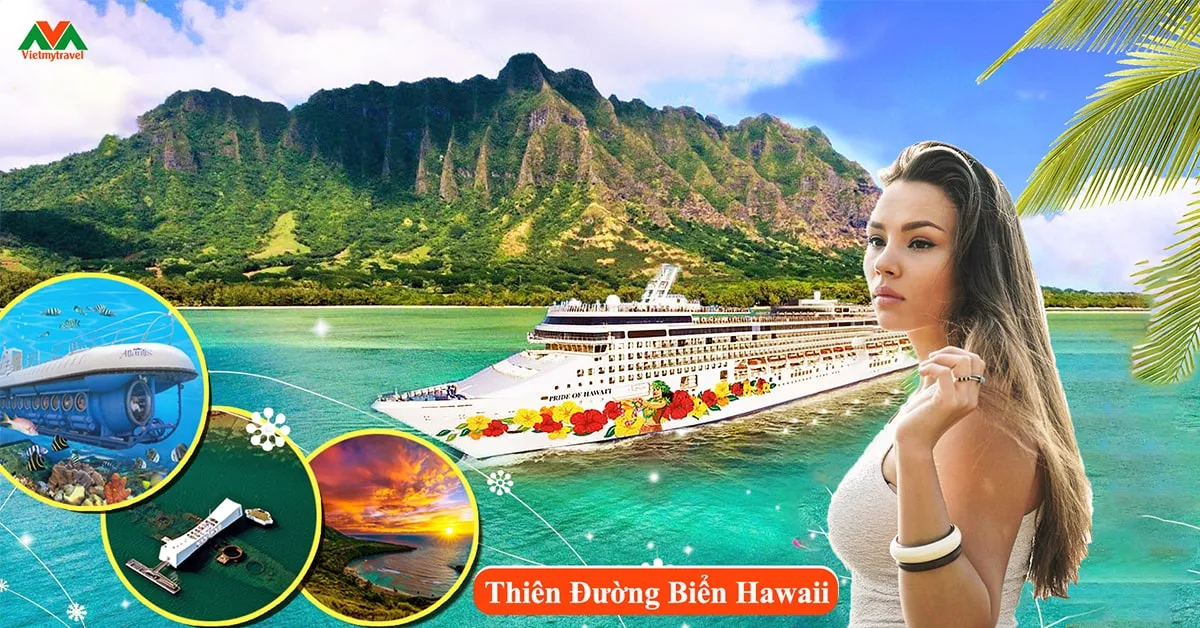Hawaii, a paradise island with stunning beaches, is not only an ideal destination for relaxation but also a wonderful place to experience exciting water sports. Among them, deep sea fishing is an unmissable experience for those passionate about conquering the ocean. Are you ready to “hunt” yellowfin tuna, marlin, or even giant swordfish? Let’s explore how to join a deep sea fishing tour in Hawaii for a memorable trip!
Discover the Allure of Deep Sea Fishing in Hawaii
Hawaii is known as the “Marlin Fishing Capital of the World” and is a premier deep sea fishing destination. The waters around the islands boast a diverse and rich ecosystem with many large fish species. Favorable weather conditions, calm seas, and professional fishing techniques make Hawaii a dream destination for every angler.
Popular Deep Sea Fish Species in Hawaii
Hawaii is home to many rare and economically valuable deep sea fish species. Here are some common species you might encounter on your fishing trip:
- Yellowfin Tuna (Ahi): This fish is famous for its delicious meat, often used for sushi and sashimi.
- Marlin: Blue marlin and striped marlin are true “warriors” of the ocean, requiring anglers to have skill and stamina.
- Swordfish: With their distinctive long bill, swordfish are among the most formidable predators.
- Wahoo: This fish has a slender body, fast swimming speed, and delicious meat.
- Mahimahi (Dolphin Fish): Also known as dolphin fish, Mahimahi have vibrant colors and a delicious flavor.

Detailed Guide on How to Join a Deep Sea Fishing Tour in Hawaii
To have a successful deep sea fishing trip in Hawaii, you need to prepare carefully and choose a suitable service. Here is a detailed guide on the steps you need to take:
1. Research and Choose a Reputable Tour Company
Currently, there are many companies offering deep sea fishing tours in Hawaii. To ensure quality and safety, you should carefully research these companies, considering the following factors:
- Experience: Prioritize companies with many years of experience in organizing deep sea fishing tours.
- Team: Ensure the company has a team of experienced captains and crew who understand the Hawaiian waters and fishing techniques.
- Boats: Check if the boats are fully equipped with safety equipment, amenities, and are regularly maintained.
- Reviews: Refer to reviews from people who have participated in tours with that company on travel websites, forums, or social media.
- Price: Compare prices between different companies to find an option that fits your budget.
2. Choose the Right Type of Tour
Companies often offer various types of deep sea fishing tours to meet the needs of different customers. Here are some popular types:
- Private Charter: Rent the entire boat for your group, suitable for families, friends, or colleagues who want privacy and flexibility.
- Shared Charter: Join others on a larger boat, saving costs and having the opportunity to socialize and make friends.
- Half-Day Trip: Shorter duration, suitable for those who do not have much time or want to try deep sea fishing for the first time.
- Full-Day Trip: Longer duration, allowing you to explore more fishing spots and increase your chances of catching big fish.

3. Book Your Tour and Prepare Necessary Documents
Once you have chosen a suitable company and tour type, you need to contact the company to book your tour. Provide complete personal information, the number of participants, departure date, and any other special requests (if any).
Regarding documents, you need to prepare:
- Passport: Valid for at least 6 months.
- US Visa: If you are not a US citizen.
- Fishing License: Some states in the US require anglers to have a fishing license. Check if Hawaii has this requirement and apply for a license if necessary.
4. Prepare Personal Items for the Trip
To have a comfortable and safe deep sea fishing trip, you should prepare the following items:
- Clothing: Choose comfortable, breathable, sun-protective, and quick-drying clothing.
- Sunscreen: Protect your skin from the harsh sunlight.
- Hat and Sunglasses: Shield your head and eyes from direct sunlight.
- Footwear: Wear sports shoes or sandals with good grip to avoid slipping on the boat.
- Medication: Bring any necessary personal medications, especially motion sickness medication if you are prone to seasickness.
- Camera: Capture memorable moments during the trip.
- Cash: To pay for any additional services or buy souvenirs.
5. Follow Safety Regulations on the Boat
During the tour, you must strictly adhere to the safety regulations of the captain and crew. Here are some important regulations:
- Always listen and follow instructions: The captain and crew are experienced and knowledgeable about these waters, trust and follow their advice.
- Wear a life jacket: Always wear a life jacket while moving on the boat, especially when the sea is rough or the weather is bad.
- Maintain a safe distance from equipment: Stay away from equipment such as fishing lines, machinery, and sharp objects to avoid injury.
- Do not drink excessive alcohol: Drinking too much alcohol can impair judgment and endanger yourself and those around you.
- Report any incidents immediately: If you encounter any problems (e.g., seasickness, injury, or see strange objects), report it to the captain or crew immediately for timely assistance.

Tips for Effective Deep Sea Fishing in Hawaii
To increase your chances of catching big fish, you can refer to some tips below:
- Choose the right time: Summer (from May to September) is the ideal time for catching yellowfin tuna and blue marlin.
- Use appropriate bait: The captain will advise you on the appropriate bait for each fish species.
- Be patient: Deep sea fishing requires patience and persistence. Don’t be discouraged if you don’t catch a fish on your first try.
- Learn from experience: Observe how other anglers operate and learn from their experience.
- Relax and enjoy: Most importantly, relax, enjoy the fresh air, and the beautiful ocean scenery.
Other Important Notes
- Protect the environment: Do not litter in the sea, and do not damage coral reefs and marine life.
- Respect local culture: Learn about Hawaiian culture and customs and respect their traditional values.
- Purchase travel insurance: Travel insurance will help you cover costs in case of accidents, illness, or loss of property.
Conclusion
Deep sea fishing in Hawaii is a wonderful experience, giving you the opportunity to explore the beauty of the ocean, challenge yourself, and create memorable moments. Hopefully, with the above information, you are now well-prepared for your deep sea fishing trip in Hawaii. Good luck and have a successful trip!